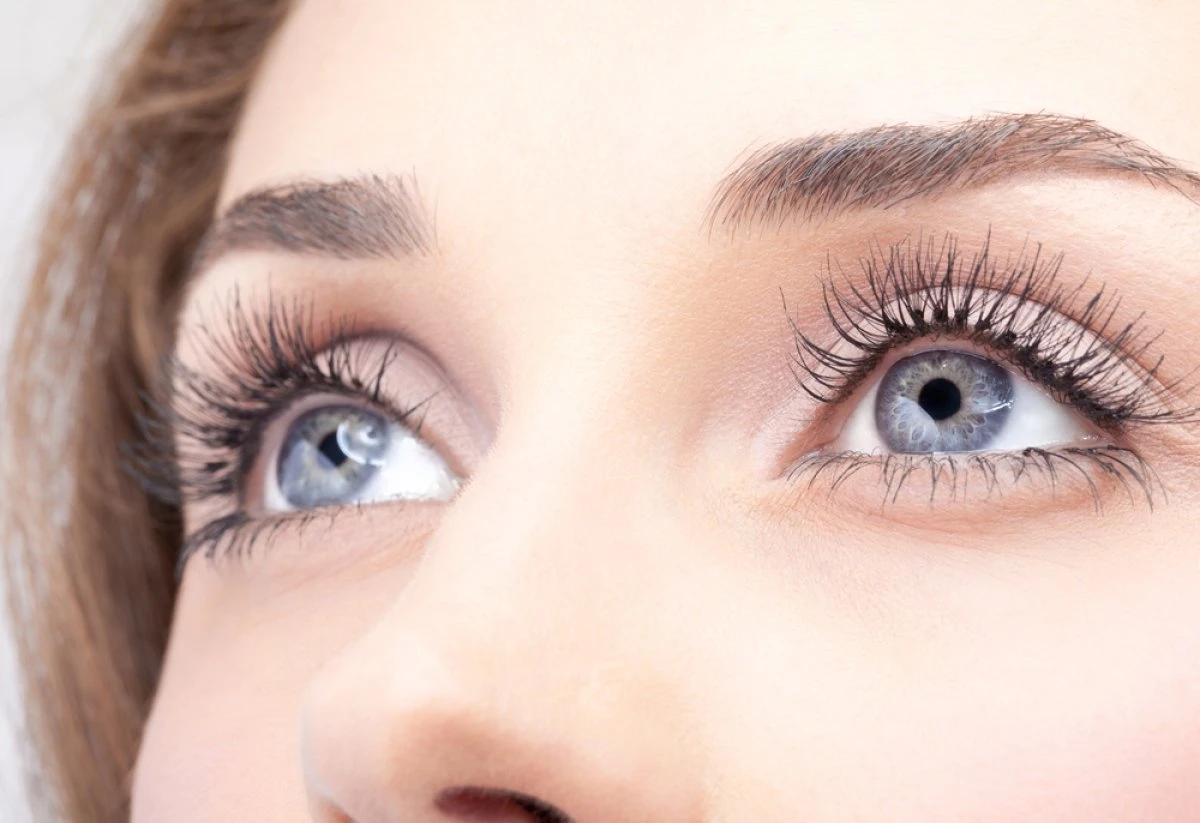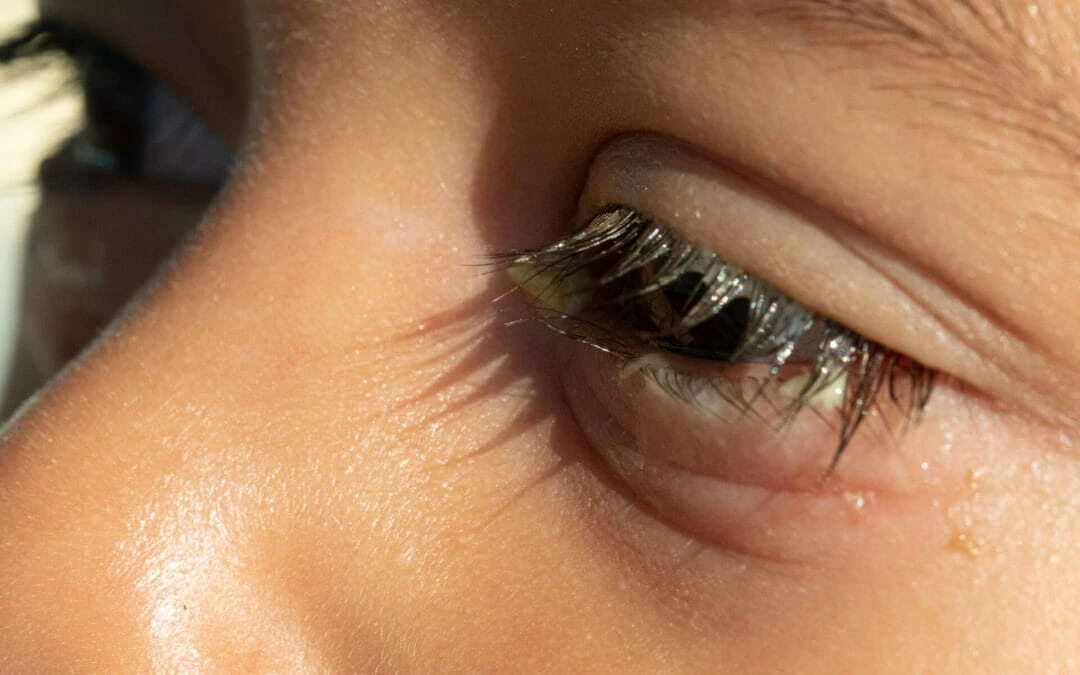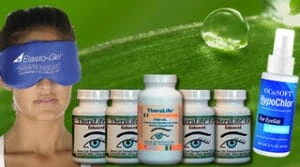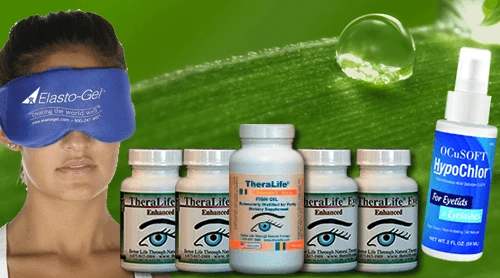Powerful Crusty Eyes Treatment /Prevention
Crusty eyes treatment involve warm compresses and eyelid cleansing. However, the root cause of crusty eyes is chronic dry eyes. Therefore treating dry eyes will relief crusty eyes and prevent recurrence.
TheraLife developed a comprehensive protocol for treating dry eyes, crusty eyes, blepharitis, MGD ( clogged oil glands) all at once to achieve optimum results.
TheraLife Comprehensive All In One Dry Eye Starter Kit
Everything you need for recovery.
Add To Cart
How Does TheraLife Eye Capsules Work?
From inside out, no more drops. Restore and revive your own tear production for balanced, sustainable comfort. Clinically proven
Customer Success Stories
Crusty Eyes Recovery
I have had blepharitis/MGD crusty eyes that would come concurrent with a pink eye for quite a few years, but it has always gone away pretty quickly on its own. However, this last time, blepharitis and dry eye did not leave, and it became pretty disruptive to my life. My eye doctor gave me eye drops, making my eyes feel drier. I felt as though I had no hope for my eyes, and they were going to keep getting worse and worse. Despite being reasonably skeptical, I finally decided to try Theralife, and I’m So glad I did. I’ve now been taking it for just over two weeks, and I already feel so much better. This morning I woke up, and my eyes were almost white instead of bright red. My blurry vision cleared up, the stickiness gone from my eyes, and the stinging had virtually gone.
I’m looking forward to them getting better and better. Thanks so much!”
Cindy, USA
———————————
Introduction
Morning eye discharge, primarily composed of mucus, oils, skin cells, and tears, plays a vital role in protecting your eyes by trapping and removing foreign particles and debris during sleep. While blinking helps clear these substances throughout the day. However, when the discharge is thick, yellowish in color and sticky, this could be due to chronic dry eyes called crusty eyes , also Blepharitis.
Blepharitis can lead to serious eye injuries left untreated.
To manage this, TheraLife provides an array of products designed to enhance eye health and comfort effectively. TheraLife’s Eye Enhanced Starter Kit and Autoimmune Starter Kit offer targeted solutions that help reduce morning crusty eyes by promoting healthy tear secretion and reducing inflammation. These kits include components like the Eye Lid Cleanser, which aids in maintaining eyelid hygiene and preventing infections that could exacerbate eye discharge.
Additionally, TheraLife’s Fish Oil supplements offer omega-3 fatty acids essential for maintaining healthy tears and eye surface. For those experiencing dry eyes due to autoimmune conditions or menopause, TheraLife’s specialized formulas help restore the eye’s natural balance and function. This not only reduces the unpleasant morning discharge but also enhances overall eye comfort and health.
Moreover, the use of TheraLife’s Hot Compress for eyes can soothe irritation and facilitate the natural cleaning mechanisms of the eyes. By incorporating TheraLife products into daily eye care routines, individuals can significantly mitigate issues related to morning eye discharge while ensuring long-term eye health and comfort. These comprehensive solutions are backed by research and tailored to meet the needs of various eye conditions, demonstrating TheraLife’s commitment to effective eye care.
Get Rid Of Crusty Eyes – Treat Your Dry Eyes With TheraLife
Crusty Eyes Management with TheraLIfe All In One Dry Eye Starter Kit.
Add To Cart
Key Takeaways
- TheraLife’s Eye Enhanced Starter Kit helps reduce morning crusty eyes by promoting healthy tear production and maintaining ocular surface integrity, mitigating the accumulation of mucus, oils, and skin cells overnight.
- Reduced blinking and tear production during sleep can lead to increased eye discharge. TheraLife Eye capsules enhance the natural tear secretion, helping to keep the eyes clearer throughout the night.
- Conditions such as allergies, infections, and blepharitis that heighten discharge can be alleviated with TheraLife’s Eye capsules, which targets underlying inflammation and improves overall eye health.
- TheraLife products aid in reducing inflammation and by strengthening the eye’s natural cleaning processes through enhanced tear quality and stability.
- To prevent exacerbation of morning discharge due to poor hygiene like residual makeup, TheraLife offers an effective Eye Lid Cleanser that ensures the eyelids are clean and free from irritants, promoting a healthier ocular environment.
Understanding Crusty Eyes In The Morning
Each morning, you might notice a crusty buildup in the corners of your eyes, commonly known as morning eye discharge or sleep crust. This phenomenon occurs due to a natural accumulation of mucus, oils, skin cells, and tears that your body produces overnight to protect and lubricate your eyes. While you’re awake, blinking and tear production help wash away this discharge, but during sleep, these mechanisms slow down, allowing the material to gather and harden at the corners of your eyes.
Understanding this process is important for maintaining proper eye hygiene. To manage morning eye discharge effectively, it’s crucial to adopt a gentle cleaning routine. Each day, you should carefully wipe away the sleep crust using a warm, damp washcloth. This method ensures that any accumulated discharge is removed, reducing the risk of irritation or infection. Additionally, maintaining cleanliness around your eye area prevents potential complications that could arise from neglecting this simple yet important practice.
Common Causes of Crusty Eyes
While crusty eyes in the morning primarily result from a natural buildup of mucus, tears, and skin cells, other factors like allergies and infections can exacerbate this condition. If you’re noticing more crust than usual, you might be dealing with an allergic reaction. Pollen, pet dander, and dust can all trigger allergic responses, leading to increased mucus production overnight. This often results in that sticky, uncomfortable eye discharge you find upon waking.
Additionally, eye conditions such as blepharitis, conjunctivitis, or eye styes also contribute greatly to crusty eyes. Blepharitis, which involves inflammation of the eyelids, often causes scaling and crusting, particularly noticeable after sleep due to reduced blinking to naturally clear away debris. Conjunctivitis, or pink eye, and styes, which are infections of the eyelid, can exacerbate eye discharge and crust formation.
To mitigate these issues, adopting proper eye hygiene is essential. Make sure to wash your face and eyelids thoroughly before bed. Removing all eye makeup is particularly important as remnants can irritate the eyes overnight and worsen discharge. Regular cleaning and occasionally using a warm compress can help maintain eye health and reduce morning crustiness.
Analyzing Sleep Debris
As you explore the reasons behind your morning crusty eyes discharge, it’s important to understand that this mixture of mucus, oils, and skin cells plays a protective role for your eyes.
Knowing the composition of sleep debris can help you determine whether your eye’s morning routine is normal or a sign of a health issue.
If you’re noticing excessive or unusual discharge, it could be impacting your eye health, warranting a closer look at your daily eye care practices.
Causes of Crusty Eyes Discharge
When you wake up with crusty corners in your eyes, it’s typically due to sleep debris, which includes mucus, skin cells, oils, and tears. This mixture accumulates overnight because, while you’re sleeping, you aren’t blinking. Blinking is your body’s natural way to help clear away these substances during the day, keeping your eyes clean and moist. Without it, the debris simply builds up until you wake and clean it away.
Understanding the causes of eye discharge is pivotal for maintaining good eye hygiene. Normally, the discharge you see in the morning is harmless and indicates that your eyes are effectively cleansing themselves. However, if you notice an increase in discharge or a change in its color or consistency, it could signal an underlying issue. Conditions like blepharitis, conjunctivitis, or dry eye syndrome might be to blame. These conditions interfere with normal eye functions and increase debris accumulation.
To prevent complications related to excessive eye discharge, you should practice proper eye hygiene. This includes regular cleansing of your eye area, avoiding touching your eyes with unclean hands, and attending routine eye exams.
If symptoms persist, consulting an eye care professional is essential for addressing any potential health concerns.
Composition of Crusty Eyes Debris
Understanding what sleep debris consists of can help you better manage your morning eye routine. Sleep debris, a natural byproduct of your body’s nightly rejuvenation process, includes mucus, oil, shed skin cells, and other small particles. This mix plays an important role in keeping your eyes clean and free from potential irritants.
However, you might wonder what exactly makes up this ‘sleep’ in your eyes. Here’s a breakdown:
| Component | Description |
|---|---|
| Mucus | Helps trap and remove particles and microbes |
| Oil | Lubricates the eyes and limits evaporation of tears |
| Skin Cells | Shed naturally from the eyelids and surrounding areas |
| Other Debris | Can include dust or residual makeup |
| Water | Constitutes tears that rinse contaminants from the eye |
It’s essential to maintain proper eye hygiene to manage sleep debris effectively. Gently cleaning your eyes with warm water each morning can prevent the buildup of excessive debris, which might indicate more serious eye conditions. Don’t underestimate the importance of this simple routine; it’s a crucial part of keeping your eyes healthy and clear from irritants that could impair your vision or comfort.
Impact on Eye Health
How does your body’s natural production of morning eye discharge impact your overall eye health?
Typically, this sleep debris, consisting of mucus, oil, and skin cells, plays an important role for your eyes during sleep. It helps to remove waste and potentially harmful debris that accumulates throughout the day. However, when you notice an unusual increase or a change in the consistency of this discharge, it might be a sign of an underlying issue.
Excessive eye discharge, especially if it’s yellow or green, could indicate more serious conditions such as dry eye or bacterial conjunctivitis, commonly known as pink eye. These conditions, if left untreated, can adversely affect your eye health, leading to more severe complications.
Dry eye, for example, occurs when your eyes don’t produce enough tears or produce poor-quality tears. This condition can lead to inflammation, pain, and sometimes an increased risk of eye infections.
Maintaining good eye hygiene by gently cleaning the lids and lashes with a warm washcloth can help manage morning eye discharge and prevent complications. If you’re experiencing persistent or severe eye discharge, it’s important to seek medical attention to address any potential eye health issues effectively.
Treatment Options for Crusty Eyes Discharge
To treat morning eye discharge, you might start by gently cleaning your eyes with a warm washcloth. This simple step helps remove any crust that’s formed overnight.
For further relief, incorporating hydrating eye drops into your routine can be beneficial. These drops aid in moisturizing your eyes, potentially reducing the recurrence of discharge by alleviating dryness that might contribute to its formation.
If your eye discharge persists or is accompanied by other symptoms such as redness, pain, or sensitivity to light, it’s important to seek medical advice. In some instances, this condition could be indicative of an underlying infection, and your healthcare provider may prescribe antibiotics as a treatment to tackle the root cause effectively.
Preventing Excessive Eye Mucus
You can reduce the likelihood of excessive morning eye discharge by practicing good eyelid hygiene, such as washing the eye area gently before bed. This simple routine helps prevent the buildup of crusty residues and lowers the risk of eye infections causing Blepharitis.
Additionally, make sure you’re not going to bed with any eye makeup on; it’s important to keep those pores unblocked to avoid irritation.
Keep your hands clean: Always wash your hands before touching your eyes. Dirty hands can transfer bacteria, leading to infections and increased mucus production.
Remove your contact lenses: Never sleep in your contacts, even if they’re labeled as overnight wear. Removing them helps prevent irritation and crusty buildup that can worsen overnight.
Use warm compresses: In the morning, gently apply a warm compress to your eyelids. This not only feels soothing but also helps loosen any crusty mucus, making it easier to wipe away without causing discomfort.
When to Consult a Doctor
If your morning eye discharge is persistent or accompanied by other troubling symptoms, it’s important to consult a doctor. Eye discharge that doesn’t clear up with regular cleaning or that recurs might indicate an underlying condition needing medical attention.
When symptoms like redness, pain, swelling, or changes in vision accompany the discharge, it’s imperative to seek help. These signs can suggest infections or other serious eye conditions that require prompt treatment.
Persistent eye discharge, especially if it’s yellow, green, or has an unusual consistency, shouldn’t be ignored. Such symptoms could point to infections like conjunctivitis or more complex issues such as corneal ulcers. Basic hygiene mightn’t suffice in these cases, and delaying professional advice can lead to complications.
Moreover, if you have chronic conditions like blepharitis, dry eye, or allergic conjunctivitis, managing your morning eye discharge goes beyond simple home care. Regular consultations with a healthcare provider are essential for effective management and to prevent exacerbation of these conditions.
Get Rid Of Crusty Eyes – Treat Your Dry Eyes With TheraLife
Crusty Eyes Management with TheraLIfe All In One Dry Eye Starter Kit.
Add To Cart
Frequently Asked Questions
Is It Normal to Have Crusty Eyes Discharge in the Morning?
Yes, it’s normal to have eye discharge in the morning, as it results from overnight accumulations of mucus, tears, and debris.
To manage this effectively, TheraLife offers a comprehensive range of products designed to enhance eye health and alleviate discomfort. TheraLife’s Eye Enhanced Starter Kit is particularly beneficial, providing natural relief for dry eyes and reducing morning eye discharge by improving tear secretion and ocular surface health.
Additionally, TheraLife’s Autoimmune Starter Kit can be helpful for those with autoimmune-related dry eyes, a condition that might exacerbate morning discharge.
For optimal eye hygiene, TheraLife’s Eye Lid Cleanser can be used to gently clean the eyelids and lashes, removing any accumulated discharge safely.
Regular use of these TheraLife products can help maintain clear, comfortable eyes throughout the day. If discharge persists or changes in color, consulting a doctor is advisable.
How Do I Get Rid of Morning Crusty Eyes Discharge?
To effectively manage morning crusty eyes discharge, consider incorporating TheraLife products into your daily routine. TheraLife offers a range of products designed to enhance eye health and alleviate symptoms like eye discharge. Their Eye Enhanced Starter Kit includes components that help stabilize tear film and reduce inflammation.
For individuals with autoimmune conditions, the Autoimmune Dry Eye Starter Kit is tailored to address the unique challenges of dry eyes in autoimmune patients.
TheraLife’s products work by restoring the eyes’ natural ability to produce tears, which can help clear out any discharge. They also offer a specialized Eye Lid Cleanser to maintain eyelid hygiene, crucial for preventing the buildup of discharge.
The use of TheraLife Fish Oil supplements can further support eye health by providing essential omega-3 fatty acids, which are known to improve the quality of the eye’s oil layer.
For more targeted treatment, TheraLife’s Hot Compress for Eyes can soothe irritated and inflamed eyes, thereby reducing morning discharge.
All these products are backed by extensive research and testimonials available on their website, highlighting their effectiveness in treating various eye conditions.
Why Is Pus Coming Out of My Eye in the Morning?
If pus is present in your eyes upon waking, it could be indicative of an infection such as bacterial blepharitis, which may be exacerbated by poor eye hygiene or improper contact lens use. To address this, TheraLife offers a range of products that could be beneficial.
TheraLife’s all-in-one Eye Enhanced Starter Kit and Autoimmune Starter Kit include components that support eye health through natural, clinically proven formulas that aim to restore your eyes’ natural tear secretion. These kits can be particularly effective for those suffering from chronic dry eyes and autoimmune dry eyes, conditions often associated with eye infections.
Additionally, TheraLife’s Eye Lid Cleanser can help maintain eyelid hygiene, thus preventing the buildup of bacteria that can lead to infections. The Hot Compress for Eyes provides a soothing treatment that can help relieve symptoms and aid in the healing process.
For those experiencing dry eyes due to menopause, TheraLife’s targeted solutions like the Menopause Dry Eyes formula are designed to counteract the specific hormonal changes affecting tear production.
Why Is Mucus Coming Out of My Eyes?
Noticing mucus in your eyes might indicate that your eyes are reacting to irritants or an underlying condition, such as Blepharitis and Chronic Dry eyes. To effectively managed using TheraLife’s range of products. TheraLife Eye Enhanced Starter Kit, designed to restore the eyes’ natural tear secretion, can be particularly beneficial in reducing excessive mucus production by stabilizing the tear film.
The Autoimmune Dry Eye Starter Kit from TheraLife addresses specific needs related to autoimmune conditions that can exacerbate eye mucus.
Additionally, TheraLife offers specialized products like Fish Oil supplements that help improve overall eye health and reduce inflammation, and a Hot Compress for Eyes which aids in loosening the mucus. Their Eye Lid Cleanser is excellent for maintaining hygienic conditions around the eyes, further preventing the accumulation of irritants that can lead to excess mucus production.
For comprehensive eye care, especially under conditions like menopause which can alter eye secretions, TheraLife’s tailored solutions such as the Menopause Dry Eyes treatment provide targeted relief.
Get Rid Of Crusty Eyes – Treat Your Dry Eyes With TheraLife
Crusty Eyes Management with TheraLIfe All In One Dry Eye Starter Kit.
Add To Cart
Conclusion
While morning eye discharge may seem routine, leveraging TheraLife‘s range of products can significantly enhance eye health and manage symptoms effectively. TheraLife offers a comprehensive approach to eye care with its all-encompassing products, including the All-in-One Eye Enhanced Starter Kit and Autoimmune Dry Eye solutions, which are designed to address various eye conditions naturally and effectively.
TheraLife’s products work by restoring the eyes’ natural ability to produce tears, reducing inflammation, and relieving dryness and irritation, which are often underlying causes of eye discharge. The Eye Lid Cleanser and Hot Compress for Eyes are particularly effective in maintaining eyelid hygiene and soothing the eyes, which helps reduce the accumulation of discharge. Additionally, the Fish Oil supplements offered by TheraLife contribute to overall eye health by providing essential nutrients.
For those suffering from specific conditions like autoimmune dry eyes or menopause-related dry eyes, TheraLife provides targeted solutions that cater to these unique needs, ensuring that each individual receives the most appropriate treatment. Moreover, TheraLife’s commitment to using science-backed ingredients and formulations ensures that users are receiving top-quality care.
In conclusion, while morning eye discharge can be a common occurrence, TheraLife offers a range of products that not only manage the condition but also promote overall eye health.
Adhering to a regimen that includes TheraLife’s scientifically formulated products can help ensure that your eyes remain clear and healthy. If symptoms persist, it’s advisable to consult a healthcare provider and consider integrating TheraLife products into your eye care routine for optimal results.
References
1. The definition and classification of dry eye disease: report of the Definition and Classification Subcommittee of the International Dry Eye WorkShop (2007). Ocul Surf. 2007 Apr;5(2):75-92. [PubMed]
2. Huang R, Su C, Fang L, Lu J, Chen J, Ding Y. Dry eye syndrome: comprehensive etiologies and recent clinical trials. Int Ophthalmol. 2022 Oct;42(10):3253-3272. [PMC free article] [PubMed]
3. Craig JP, Nichols KK, Akpek EK, Caffery B, Dua HS, Joo CK, Liu Z, Nelson JD, Nichols JJ, Tsubota K, Stapleton F. TFOS DEWS II Definition and Classification Report. Ocul Surf. 2017 Jul;15(3):276-283. [PubMed]
4. King-Smith PE, Fink BA, Hill RM, Koelling KW, Tiffany JM. The thickness of the tear film. Curr Eye Res. 2004 Oct-Nov;29(4-5):357-68. [PubMed]
5. King-Smith PE, Fink BA, Fogt N, Nichols KK, Hill RM, Wilson GS. The thickness of the human precorneal tear film: evidence from reflection spectra. Invest Ophthalmol Vis Sci. 2000 Oct;41(11):3348-59. [PubMed]
6. Chen Q, Wang J, Tao A, Shen M, Jiao S, Lu F. Ultrahigh-resolution measurement by optical coherence tomography of dynamic tear film changes on contact lenses. Invest Ophthalmol Vis Sci. 2010 Apr;51(4):1988-93. [PMC free article] [PubMed]
7. Willcox MDP, Argüeso P, Georgiev GA, Holopainen JM, Laurie GW, Millar TJ, Papas EB, Rolland JP, Schmidt TA, Stahl U, Suarez T, Subbaraman LN, Uçakhan OÖ, Jones L. TFOS DEWS II Tear Film Report. Ocul Surf. 2017 Jul;15(3):366-403. [PMC free article] [PubMed]
8. Peng CC, Cerretani C, Braun RJ, Radke CJ. Evaporation-driven instability of the precorneal tear film. Adv Colloid Interface Sci. 2014 Apr;206:250-64. [PubMed]
9. Zhou L, Beuerman RW. Tear analysis in ocular surface diseases. Prog Retin Eye Res. 2012 Nov;31(6):527-50. [PubMed]
10. Mantelli F, Mauris J, Argüeso P. The ocular surface epithelial barrier and other mechanisms of mucosal protection: from allergy to infectious diseases. Curr Opin Allergy Clin Immunol. 2013 Oct;13(5):563-8. [PMC free article] [PubMed]
11.O’Neil EC, Henderson M, Massaro-Giordano M, Bunya VY. Advances in dry eye disease treatment. Curr Opin Ophthalmol. 2019 May;30(3):166-178. [PMC free article] [PubMed]
12. Fjaervoll K, Fjaervoll H, Magno M, Nøland ST, Dartt DA, Vehof J, Utheim TP. Review on the possible pathophysiological mechanisms underlying visual display terminal-associated dry eye disease. Acta Ophthalmol. 2022 Dec;100(8):861-877. [PMC free article] [PubMed]
13. Craig JP, Nelson JD, Azar DT, Belmonte C, Bron AJ, Chauhan SK, de Paiva CS, Gomes JAP, Hammitt KM, Jones L, Nichols JJ, Nichols KK, Novack GD, Stapleton FJ, Willcox MDP, Wolffsohn JS, Sullivan DA. TFOS DEWS II Report Executive Summary. Ocul Surf. 2017 Oct;15(4):802-812. [PubMed]
14. Qian L, Wei W. Identified risk factors for dry eye syndrome: A systematic review and meta-analysis. PLoS One. 2022;17(8):e0271267. [PMC free article] [PubMed]
15. I Y Hasan ZA. Dry eye syndrome risk factors: A systemic review. Saudi J Ophthalmol. 2021 Apr-Jun;35(2):131-139. [PMC free article] [PubMed]
16. Paulsen AJ, Cruickshanks KJ, Fischer ME, Huang GH, Klein BE, Klein R, Dalton DS. Dry eye in the beaver dam offspring study: prevalence, risk factors, and health-related quality of life. Am J Ophthalmol. 2014 Apr;157(4):799-806. [PMC free article] [PubMed]
17. Chang CJ, Somohano K, Zemsky C, Uhlemann AC, Liebmann J, Cioffi GA, Al-Aswad LA, Lynch SV, Winn BJ. Topical Glaucoma Therapy Is Associated With Alterations of the Ocular Surface Microbiome. Invest Ophthalmol Vis Sci. 2022 Aug 02;63(9):32. [PMC free article] [PubMed]
18. Andole S, Senthil S. Ocular Surface Disease and Anti-Glaucoma Medications: Various features, Diagnosis, and Management Guidelines. Semin Ophthalmol. 2023 Feb;38(2):158-166. [PubMed]
19. Sobolewska B, Schaller M, Zierhut M. Rosacea and Dry Eye Disease. Ocul Immunol Inflamm. 2022 Apr 03;30(3):570-579. [PubMed]
20. Bilgic AA, Kocabeyoglu S, Dikmetas O, Tan C, Karakaya J, Irkec M. Influence of video display terminal use and meibomian gland dysfunction on the ocular surface and tear neuromediators. Int Ophthalmol. 2023 May;43(5):1537-1544. [PubMed]






